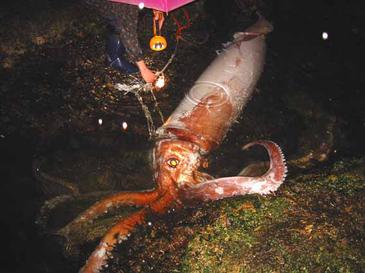
The first photographs of a live giant squid in its natural habitat were taken on 30 September 2004, by Tsunemi Kubodera (National Science Museum of Japan) and Kyoichi Mori (Ogasawara Whale Watching Association).[2] Their teams had worked together for nearly two years to accomplish this. They used a five-ton fishing boat and only two crew members. The images were created on their third trip to a known sperm whale hunting ground 970 km (600 mi) south of Tokyo, where they had dropped a 900-m (3000-ft) line baited with squid and shrimp. The line also held a camera and a flash. After over 20 tries that day, an 8 m (26 ft) giant squid attacked the lure and snagged its tentacle. The camera took over 500 photos before the squid managed to break free after four hours. The squid's 5.5 m (18 ft) tentacle remained attached to the lure. Later DNA tests confirmed the animal as a giant squid.[2]



On 27 September 2005, Kubodera and Mori released the photographs to the world. The photo sequence, taken at a depth of 900 metres (3,000 ft) off Japan's Ogasawara Islands, shows the squid homing in on the baited line and enveloping it in "a ball of tentacles". The researchers were able to locate the likely general location of giant squid by closely tailing the movements of sperm whales. According to Kubodera, "we knew that they fed on the squid, and we knew when and how deep they dived, so we used them to lead us to the squid." Kubodera and Mori reported their observations in the journal Proceedings of the Royal Society.[2]

Among other things, the observations demonstrate actual hunting behaviors of adult Architeuthis, a subject on which there had been much speculation. The photographs showed an aggressive hunting pattern by the baited squid, leading to it impaling a tentacle on the bait ball's hooks. This may disprove the theory that the giant squid is a drifter which eats whatever floats by, rarely moving so as to conserve energy. It seems the species has a much more aggressive feeding technique.

First video of live adult
In November 2006, American explorer and diver Scott Cassell led an expedition to the Sea of Cortez with the aim of filming a giant squid in its natural habitat. The team employed a novel filming method: using a Humboldt squid carrying a specially designed camera clipped to its fin. The camera-bearing squid caught on film what was claimed to be a giant squid, with an estimated length of 40 feet (12 m), engaging in predatory behavior.[42][43] The footage aired a year later on a History Channel program, MonsterQuest: Giant Squid Found.[43] Cassell subsequently distanced himself from this documentary, claiming that it contained multiple factual and scientific errors.[44]
On 4 December 2006, an adult giant squid was caught on video near the Ogasawara Islands, 1,000 km (620 mi) south of Tokyo, by researchers from the National Science Museum of Japan led by Tsunemi Kubodera. It was a small female about 3.5 m (11 ft) long and weighing 50 kg (110 lb). The bait used by the scientists initially attracted a medium-sized squid measuring around 55 cm (22 in), which in turn attracted the giant squid. It was pulled aboard the research vessel, but died in the process.[45]

In July 2012, a crew from television networks NHK and Discovery Channel captured what they describe as "the first-ever footage of a live giant squid in its natural habitat".[4][46] The footage was revealed on a NHK Special on 13 January 2013,[47][48] and was shown on Discovery Channel's show Monster Squid: The Giant Is Real on 27 January 2013,[48][49] and on Giant Squid: Filming the Impossible – Natural World Special on BBC Two.[50] The squid was about 3 m (9.8 ft) long and was missing its feeding tentacles, likely from a failed attack by a sperm whale. It was drawn into viewing range by both artificial bioluminescence created to mimic panicking jellyfish and by using a Thysanoteuthis rhombus (diamond squid) as bait. The giant squid was filmed feeding for about 23 minutes by Tsunemi Kubodera until it departed.[51]
>

taken from: https://en.wikipedia.org/wiki/Giant_squid [30.09.2013]

No comments:
Post a Comment